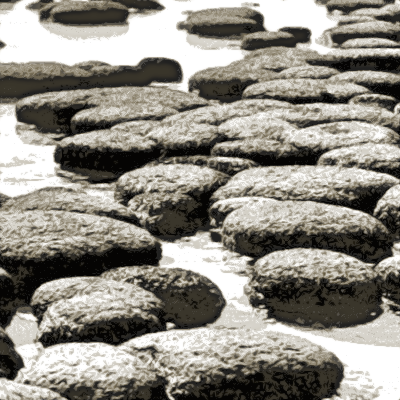 At this point mention must be made of some characteristic fossil structures that were widespread during most of the Archean and Proterozoic Eons of the geological time scale (from 4 to 0.6 billion years ago).
At this point mention must be made of some characteristic fossil structures that were widespread during most of the Archean and Proterozoic Eons of the geological time scale (from 4 to 0.6 billion years ago).

Rarely seen in the world today (examples exist in ![]() Shark Bay, Western Australia), they are thought to have been present along most shallow-water shorelines in those ancient times.
Shark Bay, Western Australia), they are thought to have been present along most shallow-water shorelines in those ancient times.
They are stromatolites: domed, multi-layered structures produced from the, usually, calcareous secretions of cyanobacteria and other organisms. The latter would occupy the uppermost layer of the structure until it became covered in marine silt.
The organisms would then migrate upwards until they were on the new surface and proceed to secrete a new calcareous layer. This process occurred very frequently so that many laminations would only add about a centimetre to the height.
Because of the domed shape, growth took place laterally as well as upwards until thousands of stromatolites, each capable of attaining a few metres height and width, would fuse together to form a stratum of stromatolic limestone.
Stromatolites largely ceased to form however when browsing invertebrates increased in numbers to the extent that severe overgrazing halted stromatolite formation.
Stromatolites are well known in rocks of the ![]() Bulawayan Group in Zimbabwe, dating from about 3.2 billion years ago and in the
Bulawayan Group in Zimbabwe, dating from about 3.2 billion years ago and in the ![]() Bitter Springs Cherts, Central Australia, 0.9 billion years old. In these localities, too, are seen a wide variety of unicellular and filamentous Cyanobacteria, some apparently with cells undergoing cell division.
Bitter Springs Cherts, Central Australia, 0.9 billion years old. In these localities, too, are seen a wide variety of unicellular and filamentous Cyanobacteria, some apparently with cells undergoing cell division.